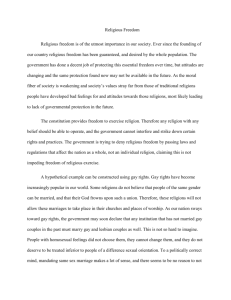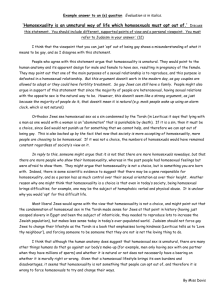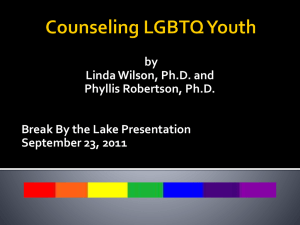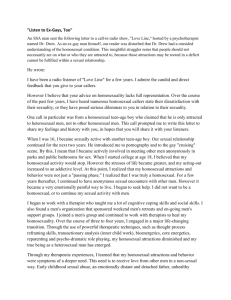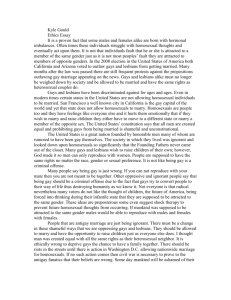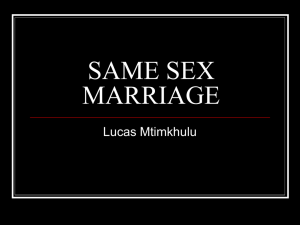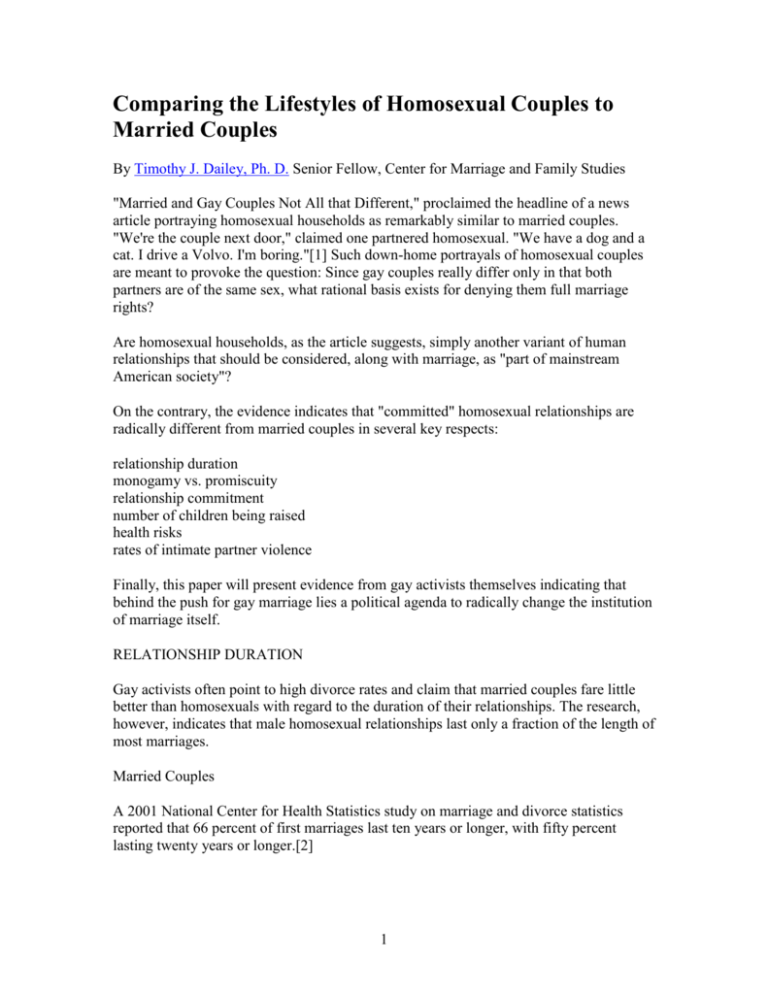
Comparing the Lifestyles of Homosexual Couples to
Married Couples
By Timothy J. Dailey, Ph. D. Senior Fellow, Center for Marriage and Family Studies
"Married and Gay Couples Not All that Different," proclaimed the headline of a news
article portraying homosexual households as remarkably similar to married couples.
"We're the couple next door," claimed one partnered homosexual. "We have a dog and a
cat. I drive a Volvo. I'm boring."[1] Such down-home portrayals of homosexual couples
are meant to provoke the question: Since gay couples really differ only in that both
partners are of the same sex, what rational basis exists for denying them full marriage
rights?
Are homosexual households, as the article suggests, simply another variant of human
relationships that should be considered, along with marriage, as "part of mainstream
American society"?
On the contrary, the evidence indicates that "committed" homosexual relationships are
radically different from married couples in several key respects:
relationship duration
monogamy vs. promiscuity
relationship commitment
number of children being raised
health risks
rates of intimate partner violence
Finally, this paper will present evidence from gay activists themselves indicating that
behind the push for gay marriage lies a political agenda to radically change the institution
of marriage itself.
RELATIONSHIP DURATION
Gay activists often point to high divorce rates and claim that married couples fare little
better than homosexuals with regard to the duration of their relationships. The research,
however, indicates that male homosexual relationships last only a fraction of the length of
most marriages.
Married Couples
A 2001 National Center for Health Statistics study on marriage and divorce statistics
reported that 66 percent of first marriages last ten years or longer, with fifty percent
lasting twenty years or longer.[2]
1
Source: National Center for Health Statistics, Centers for Disease Control and Prevention
(2001)
A 2002 U.S. Census Bureau study reported similar results, with 70.7 percent of women
married between 1970 and 1974 reaching their tenth anniversary and 57.7 percent staying
married for twenty years or longer.[3]
2
Source: Current Population Reports: U.S. Census Bureau (2002)
Male Homosexual Relationships
The 2003-2004 Gay/Lesbian Consumer Online Census surveyed the lifestyles of 7,862
homosexuals. Of those involved in a "current relationship," only 15 percent describe their
current relationship as having lasted twelve years or longer, with five percent lasting
more than twenty years.[4] While this "snapshot in time" is not an absolute predictor of
the length of homosexual relationships, it does indicate that few homosexual relationships
achieve the longevity common in marriages.
3
Source: 2003-2004 Gay/Lesbian Consumer Online Census
In The Sexual Organization of the City, University of Chicago sociologist Edward
Laumann argues that "typical gay city inhabitants spend most of their adult lives in
'transactional' relationships, or short-term commitments of less than six months."[5]
A study of homosexual men in the Netherlands published in the journal AIDS found that
the "duration of steady partnerships" was 1.5 years.[6]
In his study of male homosexuality in Western Sexuality: Practice and Precept in Past
and Present Times, Pollak found that "few homosexual relationships last longer than two
years, with many men reporting hundreds of lifetime partners."[7]
In Male and Female Homosexuality, Saghir and Robins found that the average male
homosexual live-in relationship lasts between two and three years.[8]
MONOGAMY VS. PROMISCUITY: SEXUAL PARTNERS OUTSIDE OF THE
RELATIONSHIP
Lest anyone suffer the illusion that any equivalency between the sexual practices of
homosexual relationships and traditional marriage exists, the statistics regarding sexual
fidelity within marriage are revealing:
Married couples
A nationally representative survey of 884 men and 1,288 women published in the Journal
of Sex Research found that 77 percent of married men and 88 percent of married women
had remained faithful to their marriage vows.[9]
4
A 1997 national survey appearing in The Social Organization of Sexuality: Sexual
Practices in the United States found that 75 percent of husbands and 85 percent of wives
never had sexual relations outside of marriage.[10]
A telephone survey conducted for Parade magazine of 1,049 adults selected to represent
the demographic characteristics of the United States found that 81 percent of married
men and 85 percent of married women reported that they had never violated their
marriage vows.[11]
Male Homosexuals
Research indicates that the average male homosexual has hundreds of sex partners in his
lifetime:
The Dutch study of partnered homosexuals, which was published in the journal AIDS,
found that men with a steady partner had an average of eight sexual partners per year.[12]
Bell and Weinberg, in their classic study of male and female homosexuality, found that
43 percent of white male homosexuals had sex with 500 or more partners, with 28
percent having one thousand or more sex partners.[13]
In their study of the sexual profiles of 2,583 older homosexuals published in the Journal
of Sex Research, Paul Van de Ven et al. found that "the modal range for number of sexual
partners ever [of homosexuals] was 101-500." In addition, 10.2 percent to 15.7 percent
had between 501 and 1,000 partners. A further 10.2 percent to 15.7 percent reported
having had more than one thousand lifetime sexual partners.[14]
A survey conducted by the homosexual magazine Genre found that 24 percent of the
respondents said they had had more than one hundred sexual partners in their lifetime.
The magazine noted that several respondents suggested including a category of those who
had more than one thousand sexual partners.[15]
"Commitment" in Male Homosexual Couples
Even in those homosexual relationships in which the partners consider themselves to be
in a committed relationship, the meaning of "committed" or "monogamous" typically
means something radically different than in heterosexual marriage.
A Canadian study of homosexual men who had been in committed relationships lasting
longer than one year found that only 25 percent of those interviewed reported being
monogamous." According to study author Barry Adam, "Gay culture allows men to
explore different...forms of relationships besides the monogamy coveted by
heterosexuals."[16]
5
The Handbook of Family Diversity reported a study in which "many self-described
'monogamous' couples reported an average of three to five partners in the past year.
Blasband and Peplau (1985) observed a similar pattern."[17]
In The Male Couple, authors David P. McWhirter and Andrew M. Mattison reported that,
in a study of 156 males in homosexual relationships lasting from one to thirty-seven
years:
Only seven couples have a totally exclusive sexual relationship, and these men all have
been together for less than five years. Stated another way, all couples with a relationship
lasting more than five years have incorporated some provision for outside sexual activity
in their relationships.[18]
As the following chart shows, the extremely low rate of sexual fidelity among
homosexual men dramatically contrasts with the high rate of fidelity among married
heterosexuals.
Sources:Laumann, The Social Organization of Sexuality, 216; McWhirter and Mattison,
The Male Couple: How Relationships Develop (1984): 252-253; Wiederman,
"Extramarital Sex," 170.
According to McWhirter and Mattison, most homosexual men understood sexual
relations outside the relationship to be the norm and viewed adopting monogamous
standards as an act of oppression.
In their Journal of Sex Research study of the sexual practices of older homosexual men,
Paul Van de Ven et al. found that only 2.7 percent of older homosexuals had only one
sexual partner in their lifetime.[19]
6
Brad Hayton provides insight into the attitudes of many homosexuals towards
commitment and marriage:
Homosexuals...are taught by example and belief that marital relationships are transitory
and mostly sexual in nature. Sexual relationships are primarily for pleasure rather than
procreation. And they are taught that monogamy in a marriage is not the norm [and]
should be discouraged if one wants a good "marital" relationship.[20]
While the rate of fidelity within marriage cited by these studies remains far from ideal,
there is a significant difference between the negligible lifetime fidelity rate cited for
homosexuals and the 75 to 90 percent cited for married couples. This indicates that even
"committed" homosexual relationships display a fundamental incapacity for the
faithfulness and commitment that is axiomatic to the institution of marriage.
LEVEL OF COMMITMENT IN HOMOSEXUAL RELATIONSHIPS
If homosexuals and lesbians truly desired the same kind of commitment signified by
marriage, then one would expect them to take advantage of the opportunity to enter into
civil unions or registered partnerships, which grant them legal recognition as well as the
legal rights of marriage. However, surprisingly few homosexuals and lesbians choose to
enter into such legally recognized unions where such arrangements are available,
indicating that such couples do not share the same view of commitment as typified by
married couples.
Vermont
In April 2000, the governor of the state of Vermont signed a law instituting civil unions
for homosexuals. The bill conferred 300 privileges and rights enjoyed by married couples
upon same-sex partners who register their relationship with the town clerk and have their
union solemnized by a member of the clergy or the justice of the peace.
Estimating the homosexual and lesbian population of Vermont: The number of
homosexuals and lesbians in the state of Vermont may be estimated based on national
studies. Contrary to the widely promulgated but inaccurate claims that up to ten percent
of the population is homosexual, research indicates that homosexuals comprise one to
three percent of the population. For example, a recent study in Demography relying upon
three large data sets--the General Social Survey, the National Health and Social Life
Survey, and the U.S. Census--estimated the number of exclusive male homosexuals in the
general population to be 2.5 percent and the number of exclusive lesbians to be 1.4
percent.[21]
According to the 2000 Census, the adult population of Vermont is 461,304.[22] Based on
the Demography study, a reasonable estimate of the number of homosexuals and lesbians
in Vermont would be approximately 5,600 (2.5 percent of the adult male population) for
male homosexuals, and approximately 3,300 (1.4 percent of the adult female population)
7
for lesbians, for a total of approximately 8,900 homosexuals and lesbians. [Note: these
are only rough approximations for purposes of statistical comparison.]
Number of homosexuals and lesbians in Vermont who have entered into civil
unions: USA Today reports that, as of January 2004, only 936 homosexual or lesbian
couples (for a total of 1,872 individuals) have entered into civil unions.[23] This indicates
that only about 21 percent of the estimated homosexual and lesbian population of
Vermont has entered into civil unions. Put another way, 79 percent of homosexuals and
lesbians in Vermont choose not to enter into civil unions.
By contrast, in Vermont, heterosexual married couples outnumber cohabiting couples by
a margin of 7 to 1, indicating a much higher level of desire on the part of heterosexual
couples to legalize their relationships.[24]
For purposes of comparison it may be useful to examine two countries that have granted
special rights to homosexuals, including marriage-like civil unions, which grant gays and
lesbians virtually all of the rights of marriage.
Sweden
In 1995 Sweden passed the Registered Partnership Act which created civil unions for
homosexual couples. In 2003 that law was amended to give registered homosexual
couples the same right to adopt or have legal custody of children as married couples. The
percentage of homosexual or lesbians in Sweden that enter into civil unions may be
estimated as fo llows:
Estimated homosexual and lesbian population of Sweden: Extrapolating from the
Demography estimates in the U.S., a similar percentage of the homosexual and lesbian
population of Sweden would be approximately 140,000 (2.5 percent of the adult male
population of 3,531,554, and 1.4 percent of the adult female population of
3,679,317).[25]
Number of homosexuals and lesbians in Sweden who have registered their unions:
The number of registered same-sex unions in Sweden is reported to be about 1,500 (for a
total of 3,000 individuals) out of the estimated homosexual and lesbian population of
140,000.[26] This indicates that only about two percent of Swedish homosexuals and
lesbians choose to enter into legally recognized unions. Put another way, about 98
percent of Swedish homosexuals and lesbians do not officially register as same-sex
couples.
The Netherlands
A landmark law allowing same-sex "marriage" was instituted in the Netherlands on
March 31, 2001, with a highly publicized communal ceremony that included two lesbian
"brides" and six homosexual "grooms." The Netherlands instituted a "registered
partnership" law in 1998 that accorded legal status to homosexual relationships similar to
8
that of marriage. The new law, which explicitly recognizes same-sex matrimony, is
restricted to Dutch nationals. However, as the following analysis shows, the percentage
of homosexuals and lesbians that have entered into marriage-like civil unions is very low.
Estimated homosexual and lesbian population of the Netherlands: Extrapolating from
demographic figures for homosexuals and lesbians in the U.S., a similar percentage for
the Netherlands would be 242,000 (2.5 percent of the adult male population of 6,161,662,
and 1.4 percent of the adult female population of 6,311,338).[27]
Number of Dutch homosexuals and lesbians who have registered their unions: A
news report by the Gay Financial Network predicted that "some 10,000 gay couples
could be married" in the first year following the legalization of gay "marriage" in the
Netherlands. In reality, far fewer chose to solemnize their relationships. The Office of
Legislative Research released a report in October 2002 stating: "The Dutch Ministry of
Economic Affairs reports that 3,383 of the 121,776 marriages licensed between April 1,
2001, and June 30, 2002, involved people of the same sex."[28]
Thus, as of October 2002, only 2.8 percent, or 6,766 individuals (3,383 licenses) out of
an estimated homosexual and lesbian population of 242,000, have registered their unions
as "married."
Sources:U.S. Census Bureau, Married-Couple and Unmarried-Partner Households:
2000, 2; Black, "Demographics," 141; U.S. Census Bureau Census 2000 Summary File 1;
Bayles, "Vermont's Gay Civil Unions," 1; Census 2000 Special Reports, 4; Shane, "Many
Swedes Say 'I Don't,'" 1; "ORL Backgrounder," 1.
9
The much lower rates of homosexual and lesbian civil "marriages" in Sweden and the
Netherlands must be viewed in the light of much lower marriage rates in both of those
countries, a trend that the introduction of gay "marriage" in the 1990s has not reversed.
Thus, as writer Stanley Kurtz argues, the granting of marriage rights to homosexuals and
lesbians "has further undermined the institution" of marriage: "Scandinavian gay
marriage has driven home the message that marriage itself is outdated, and that virtually
any family form, including out-of-wedlock parenthood, is acceptable."[29]
Conclusion: Level of Relationship Commitment Among Homosexuals
Data from Vermont, Sweden, and the Netherlands reveal that only a small percentage of
homosexuals and lesbians identify themselves as being in a committed relationship, with
even fewer taking advantage of civil unions or, in the case of the Netherlands, of samesex "marriage." This indicates that even in the most "gay friendly" localities, the vast
majority of homosexuals and lesbians display little inclination for the kind of lifelong,
committed relationships that they purport to desire to enter.
NUMBER OF CHILDREN BEING RAISED IN HOMOSEXUAL HOUSEHOLDS
Inflated Statistics for Homosexual Households in the United States
Claims regarding the numbers of children being raised in homosexual and lesbian
households vary widely and are often unsubstantiated. According to a study on
homosexual parenting in the American Sociological Review, researchers have given
figures "of uncertain origin, depicting a range of...6 to 14 million children of gay or
lesbian parents in the United States."[30]
According to the study's authors, Judith Stacey and Timothy J. Biblarz, the higher
estimates are based upon "classifying as a lesbigay [sic] parent anyone who reports that
even the idea of homoerotic sex is appealing."[31] Instead, the authors favor a figure of
about one million, which "derives from the narrower...definition of a lesbigay parent as
one who self-identifies as such."[32]
However, even the lower figure of one million children being raised in gay and lesbian
households does not stand up to statistical analysis.
The U.S. Census Bureau reports that there are 594,391 same-sex unmarried partner
households in the United States (301,026 male homosexual households and 293,365
lesbian households).[33] This indicates that only one percent of the total of 59,969,000
households contain same-sex partners. Assuming the Stacey/Biblarz estimate that one
million children have a homosexual or lesbian parent, this would mean that, on average,
every homosexual household has at least one child.[34]
However, the 2000 Census figures show that only 33 percent (or 96,810) of female samesex households and 22 percent (or 66,225) of male same-sex households have their own
children living with them.[35] These 163,035 same-sex couples (or 326,070 individuals)
10
comprise only 8 percent of the estimated homosexual and lesbian population. Put another
way, 92 percent of the estimated adult population of homosexuals and lesbians in the
U.S. do not live with children. By comparison, the 2000 Census showed that 46 percent
of married couple households have at least one child living in the household.[36]
However, this figure underestimates the total number of married couples who have had
children, as many older couples have grown children who are no longer living at home.
*Sources:Black, "Demographics," 141; Census 2000 Special Reports, 4.
The Stacey/Biblarz estimates may include children being raised by single homosexuals,
some of whom are raising their own biological children conceived in a previous
heterosexual relationship. Nevertheless, these calculations indicate how absurdly inflated
most of the estimates are concerning the number of children being raised by
homosexuals. Far from being the proven success that some claim, homosexual parenting
remains very much the exception rather than the rule.
Implications for Homosexual Parenting
Gay activists attempt to minimize the differences between homosexual and heterosexual
households in order to make homosexuality look as normal as possible. However, as
already shown, only a small minority of gay and lesbian households have children.
Beyond that, the evidence also indicates that comparatively few homosexuals choose to
establish households together--the type of setting that is normally prerequisite for the
rearing of children.
11
The Human Rights Campaign, a homosexual advocacy organization, claims that the U.S.
population of gays and lesbians is 10,456,405, or five percent of the total U.S. population
over 18 years of age.[37] However, as we have seen, the best available data supports a
lower estimate of 2.5 percent for male homosexuals and 1.4 percent for lesbians.[38] This
would lead to a figure of approximately 4,040,000 homosexual men and women in the
U.S. population. Thus, only about 30 percent of homosexuals (1,202,418 out of some 4
million) choose to live in a household with a person of the same sex.
The above indicates that only a small minority of gays and lesbians choose to live in
partnered relationships, and furthermore, only a small percentage of partnered
homosexual households actually have children. The evidence thus does not support the
claim that significant numbers of homosexuals desire to provide a stable home for
children.
HEALTH RISKS
Even those homosexual relationships that are loosely termed "monogamous" do not
necessarily result in healthier behavior. The evidence indicates that homosexual and
lesbian relationships are at far greater risk for contracting life-threatening disease
compared with married couples:
The journal AIDS reported that men involved in relationships engaged in anal intercourse
and oral-anal intercourse with greater frequency than did those without a steady
partner.[39] Anal intercourse has been linked with a host of sexually transmitted diseases,
including AIDS.
The exclusivity of the relationship did not diminish the incidence of unhealthy sexual
acts, which are commonplace among homosexuals. An English study published in the
same issue of AIDS concurred, finding that most "unsafe" sex acts among homosexuals
occur in steady relationships.[40]
A study of steady and casual male homosexual relationships in Amsterdam found that
"steady partners contribute to (HIV) incidence more than casual partners. This can mainly
be explained by the fact that risky behavior with steady partners is much greater than that
with casual partners (30 versus 1.5 UAI [unprotected anal intercourse] acts
annually)."[41]
These findings confirmed an earlier study by the Dutch Department of Health and
Environment, which found that 67 percent of HIV-positive men aged 30 and younger had
been infected by a steady partner. The study concluded: "In recent years, young gay men
have become more likely to contract HIV from a steady sexual partner than from a casual
one."[42]
"Exclusive" Lesbian Relationships Also at Risk
12
The assumption that lesbians involved in exclusive sexual relationships are at reduced
risk for sexual disease is false:
The journal Sexually Transmitted Infections concludes: "The risk behavior profile of
exclusive WSW (women who have sex with women) was similar to all wsw."[43] One
reason for this is because lesbians "were significantly more likely to report past sexual
contact with a homosexual or bisexual man and sexual contact with an IDU (intravenous
drug user)."[44]
Greater Risk for Suicide
Homosexual and lesbian relationships experience a far greater rate of mental health
problems compared to married couples.
A twins study that examined the relationship between homosexuality and suicide,
published in the Archives of General Psychiatry, found that homosexuals with same-sex
partners were at greater risk for overall mental health problems and were 6.5 times more
likely than their twins to have attempted suicide. The higher rate was not attributable to
mental health or substance abuse disorders.[45]
INTIMATE PARTNER VIOLENCE Lesbian and Homosexual Relationships
Research indicates very high levels of violence in homosexual and lesbian relationships:
A study in the Journal of Interpersonal Violence examined conflict and violence in
lesbian relationships. The researchers found that 90 percent of the lesbians surveyed had
been recipients of one or more acts of verbal aggression from their intimate partners
during the year prior to this study, with 31 percent reporting one or more incidents of
physical abuse.[46]
In a survey of 1,099 lesbians, the Journal of Social Service Research found that slightly
more than half of the lesbians reported that they had been abused by a female
lover/partner. The researchers found that "the most frequently indicated forms of abuse
were verbal/emotional/psychological abuse and combined physical-psychological
abuse."[47]
A study of lesbian couples reported in the Handbook of Family Development and
Intervention "indicates that 54 percent had experienced 10 or more abusive incidents, 74
percent had experienced six or more incidents, 60 percent reported a pattern to the abuse,
and 71 percent said it grew worse over time."[48]
In their book Men Who Beat the Men Who Love Them: Battered Gay Men and Domestic
Violence, Island and Letellier postulate that "the incidence of domestic violence among
gay men is nearly double that in the heterosexual population."[49]
Gay and lesbian vs. other opposite-sex intimate partner relationships
13
Surveys conducted by the U.S. Department of Justice confirm that homosexual and
lesbian relationships had a far greater incidence of domestic partner violence than
opposite-sex relationships including cohabitation or marriage.
The National Violence against Women Survey, sponsored by the National Institute of
Justice, found that "same-sex cohabitants reported significantly more intimate partner
violence than did opposite-sex cohabitants. Thirty-nine percent of the same-sex
cohabitants reported being raped, physically assaulted, and/or stalked by a
marital/cohabitating partner at some time in their lifetimes, compared to 21.7 percent of
the opposite-sex cohabitants. Among men, the comparable figures are 23.1 percent and
7.4 percent."[50]
Source: "Extent, Nature, and Consequences of Intimate Partne r Violence," U.S.
Department of Justice: Office of Justice Programs, 30.
Marriage vs. Other Types of Intimate Partner Relationships
A Bureau of Justice Statistics (an agency of the U.S. Department of Justice) report found
that married women in traditional families experience the lowest rate of violence
compared with women in other types of relationships.[51] Women who were not married
to their "intimate partner" (i.e., were cohabiting), experienced a rate of violence four
times higher than that of married women (11.3 per thousand vs. 2.6 per thousand). [52]
14
Source: "Intimate Partner Violence," Bureau of Justice Statistics Special Report, Bureau
of Justice Statistics, January 31, 2002: 4.
Homosexual and Lesbian Couples vs. Married Couples
When homosexual and lesbian relationships are directly compared with married couples,
the difference in the domestic partner violence is pronounced:
Sources: "Extent, Nature, and Consequences of Intimate Partner Violence," U.S.
Department of Justice: Office of Justice Programs: 30; "Intimate Partner Violence,"
Bureau of Justice Statistics Special Report:11.
A POLITICAL AGENDA: REDEFINING MARRIAGE
15
By their own admission, gay activists are not simply interested in making it possible for
homosexuals and lesbians to partake of conventional married life. Rather, they aim to
change the essential character of marriage, removing precisely the aspects of fidelity and
chastity that promote stability in the relationship and the home:
Paula Ettelbrick, the former legal director of the Lambda Legal Defense and Education
Fund, has stated, "Being queer is more than setting up house, sleeping with a person of
the same gender, and seeking state approval for doing so....Being queer means pushing
the parameters of sex, sexuality, and family, and in the process transforming the very
fabric of society."[53]
Homosexual writer and activist Michelangelo Signorile speaks approvingly of those who
advocate replacing monogamy with sexually "open" relationships:
For these men the term "monogamy" simply doesn't necessarily mean sexual
exclusivity....The term "open relationship" has for a great many gay men come to have
one specific definition: A relationship in which the partners have sex on the outside often,
put away their resentment and jealousy, and discuss their outside sex with each other, or
share sex partners.[54]
The views of Signorile and Ettelbrick regarding marriage are widespread in the
homosexual community. According to the Mendola Report, a mere 26 percent of
homosexuals believe that commitment is most important in a marriage relationship.[55]
Former homosexual William Aaron explains why even homosexuals involved in
"committed" relationships do not practice monogamy:
In the gay life, fidelity is almost impossible. Since part of the compulsion of
homosexuality seems to be a need on the part of the homophile to "absorb" masculinity
from his sexual partners, he must be constantly on the lookout for [new partners].
Consequently the most successful homophile "marriages" are those where there is an
arrangement between the two to have affairs on the side while maintaining the semblance
of permanence in their living arrangement.[56]
The evidence is overwhelming that homosexual and lesbian "committed" relationships
are not the equivalent of marriage. In addition, there is little evidence that homosexuals
and lesbians truly desire to commit themselves to the kind of monogamous relationships
as signified by marriage. What remains, then, is the disturbing possibility that behind the
demands for "gay marriage" lurks an agenda of undermining the very nature of the
institution of marriage.
Timothy J. Dailey, Ph.D., is senior fellow in the Center for Marriage and Family Studies
at the Family Research Council. Dr. Dailey and Peter Sprigg recently co-authored
Getting It Straight: What the Research Says About Homosexuality.
16
1. Robert Gebeloff and Mary Jo Patterson, "Married and Gay Couples Are Not All that
Different" Times-Picayune (November 22, 2003).
2. Matthew D. Bramlett and William D. Mosher, "First Marriage Dissolution, Divorce
and Remarriage: United States," Advance Data, National Center for Health Statistics
(May 31, 2001): 1.
3. Rose M. Kreider and Jason M. Fields, "Number, Timing, and Duration of Marriages
and Divorces: 1996" Current Population Reports, P70-80, U.S. Census Bureau,
Washington, D.C. (February 2002): 5.
4. "Largest Gay Study Examines 2004 Relationships," GayWire Latest Breaking
Releases, www.glcensus.org.
5. Adrian Brune, "City Gays Skip Long-term Relationships: Study Says," Washington
Blade (February 27, 04): 12.
6. Maria Xiridou, et al, "The Contribution of Steady and Casual Partnerships to the
Incidence of HIV Infection among Homosexual Men in Amsterdam," AIDS 17 (2003):
1031.
7. M. Pollak, "Male Homosexuality," in Western Sexuality: Practice and Precept in Past
and Present Times, ed. P. Aries and A. Bejin, translated by Anthony Forster (New York,
NY: B. Blackwell, 1985): 40-61, cited by Joseph Nicolosi in Reparative Therapy of Male
Homosexuality (Northvale, New Jersey: Jason Aronson Inc., 1991): 124, 125.
8. M. Saghir and E. Robins, Male and Female Homosexuality (Baltimore: Williams and
Wilkins, 1973): 225; L. A. Peplau and H. Amaro, "Understanding Lesbian
Relationships," in Homosexuality:Social, Psychological, and Biological Issues, ed. J.
Weinrich and W. Paul (Beverly Hills: Sage, 1982).
9. Michael W. Wiederman, "Extramarital Sex: Prevalence and Correlates in a National
Survey," Journal of Sex Research 34 (1997): 170.
10. E. O. Laumann et al., The Social Organization of Sexuality: Sexual Practices in the
United States (Chicago:University of Chicago Press, 1994 ): 216.
11. "Sexual Habits of Americans Have Changed Dramatically in Ten Years: New
National Survey Finds Both Men and Women More Committed and Caring" PR
Newswire (August 4, 1994).
12. Xiridou, 1031.
13. A. P. Bell and M. S. Weinberg, Homosexualities: A Study of Diversity Among Men
and Women (New York: Simon and Schuster, 1978), pp. 308, 309; See also A. P. Bell,
17
M. S. Weinberg, and S. K. Hammersmith, Sexual Preference (Bloomington: Indiana
University Press, 1981).
14. Paul Van de Ven et al., "A Comparative Demographic and Sexual Profile of Older
Homosexually Active Men," Journal of Sex Research 34 (1997): 354.
15. "Sex Survey Results," Genre (October 1996), quoted in "Survey Finds 40 percent of
Gay Men Have Had More Than 40 Sex Partners," Lambda Report, January 1998: 20.
16. Ryan Lee, "Gay Couples Likely to Try Non-monogamy, Study Shows," Washington
Blade (August 22, 2003): 18.
17. David H. Demo, et al., editors, Handbook of Family Diversity (New York:Oxford
University Press, 2000): 73.
18. David P. McWhirter and Andrew M. Mattison, The Male Couple: How Relationships
Develop (Englewood Cliffs: Prentice-Hall, 1984): 252, 253.
19. Van de Ven et al., "A Comparative Demographic and Sexual Profile," 354.
20. Bradley P. Hayton, "To Marry or Not: The Legalization of Marriage and Adoption of
Homosexual Couples," (Newport Beach: The Pacific Policy Institute, 1993): 9.
21. Dan Black, et al., "Demographics of the Gay and Lesbian Population in the United
States: Evidence from Available Systematic Data Sources," Demography 37 (May 2000):
141.
22. "DP1. Profile of General Demographic Characteristics:Vermont" U.S. Census
Bureau: Census 2000 Summary File 1 (SF 1) 100-Percent Data.
23. Fred Bayles, "Vermont's Gay Civil Unions Mostly Affairs of the Heart," USA Today
(January 7, 2004): 1.
24. Tavia Simmons and Martin O'Connell, "Married-Couple and Unmarried-Partner
Households:2000," Census 2000 Special Reports (U.S. Census Bureau, February 2003),
4, Table 2. Online at: http:www.census.gov/prod/2003pubs/censr-5.pdf.
25. "Facts:Population," Directory and Complete Guide to Sweden, 2000: available at:
www.sweden.com.
26. Scott Shane, "Many Swedes Say 'I Don't' to Nuptials; Unions" Baltimore Sun
(January 16, 2004): 1A.
27. "At a Glance: Netherlands Statistics" UNICEF:available at:
http://www.unicef.org/infobycountry/netherlands_statistics.html.
18
28. "OLR Backgrounder: Legal Recognition of Same-sex Partnerships," OLR Research
Report (October 9, 2002): 1.
29. Stanley Kurtz, "The End of Marriage in Scandinavia," Weekly Standard (February 2,
2004): 26.
30. Judith Stacey and Timothy J. Biblarz, "(How) Does the Sexual Orientation of Parents
Matter?" American Sociological Review 66 (April, 2001): 167.
31. Ibid.
32. Ibid.
33. "Married-Couple and Unmarried Partner Households: 2000" (Census 2000 Special
Reports, February 2003): 2.
34. Stacey and Biblarz, 167.
35. "Married-Couple and Unmarried Partner Households: 2000," 10.
36. Ibid.
37. David M. Smith and Gary J. Gates, "Gay and Lesbian Families in the United States:
Same-Sex Unmarried Partner Households," Human Rights Campaign (August 22, 2001):
2.
38. Dan Black et al., "Demographics of the Gay and Lesbian Population," "4.7 percent of
men in the combined samples have had at least one same-sex experience since age 18, but
only 2.5 percent of men have engaged in exclusively same-sex sex over the year
preceding the survey. Similarly, 3.5 percent of women have had at least one same-sex
sexual experience, but only 1.4 percent have had exclusively same-sex sex over the year
preceding the survey." (141)
39. A.P.M. Coxon et al., "Sex Role Separation in Diaries of Homosexual Men," AIDS
(July 1993):877-882.
40. G. J. Hart et al., "Risk Behaviour, Anti-HIV and Anti-Hepatitis B Core Prevalence in
Clinic and Non-clinic Samples of Gay Men in England, 1991-1992," AIDS (July 1993):
863-869, cited in "Homosexual Marriage: The Next Demand," Position Analysis paper
by Colorado for Family Values, May 1994.
41. Xiridou, et al., 1033.
42. Jon Garbo, "More Young Gay Men are Contracting HIV from Steady Partners,"
GayHealth (July 25, 2001).
19
43. "Sexually Transmitted Infections," 347.
44. Ibid.
45. R. Herrell, et al., "A Co-Twin Study in Adult Men," Archives of General Psychiatry
56 (1999): 867-874.
46. Lettie L. Lockhart et al., "Letting out the Secret:Violence in Lesbian Relationships,"
Journal of Interpersonal Violence 9 (1994): 469-492.
47. Gwat Yong Lie and Sabrina Gentlewarrier, "Intimate Violence in Lesbian
Relationships: Discussion of Survey Findings and Practice Implications," Journal of
Social Service Research 15 (1991): 46.
48. William C. Nichols, et al, editors, Handbook of Family Development and Intervention
(New York:John Wiley and Sons, Inc., 2000): 393.
49. D. Island and P. Letellier, Men Who Beat the Men Who Love Them: Battered Gay
Men and Domestic Violence (New York: Haworth Press, 1991): 14.
50. "Extent, Nature, and Consequences of Intimate Partner Violence," U.S. Department
of Justice: Office of Justice Programs (July, 2000): 30.
51. "Intimate Partner Violence," Bureau of Justice Statistics Special Report (U.S.
Department of Justice, May, 2000): 11.
52. Ibid., 4.
53. Paula Ettelbrick, quoted in William B. Rubenstein, "Since When Is Marriage a Path
to Liberation?" Lesbians, Gay Men, and the Law, (New York: The New Press, 1993):398,
400.
54. Michelangelo Signorile, Life Outside (New York: HarperCollins, 1997): 213.
55. Mary Mendola, The Mendola Report (New York: Crown, 1980):53.
56. William Aaron, Straight (New York: Bantam Books, 1972): 208.
20

